

A short guide to Languedoc
Mediterranean France from the Rhône to the Pyrenees
| Main towns and cities | Selected cottages and B&Bs | Languedoc hotels | Small hotels in Languedoc |
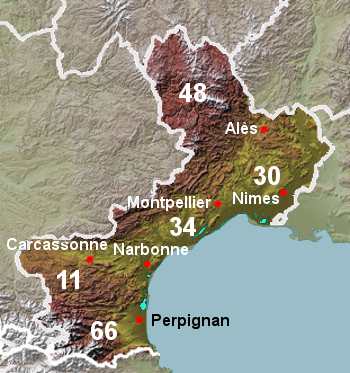
Where's where in Languedoc and Roussillon :
- Languedoc : the area as a whole, or the area excluding the department of Pyrénées Orientales (66).
- Roussillon : the French part of historic Catalonia, essentially corresponding to the department of Pyrénées Orientales (66), in the south of the region.
- Cevennes : mountainous area running from north of Montpellier to the northeast of Languedoc, mostly in the Gard (30) and Lozère (48) departments. Highest point Mont Lozère - 1702 metres.
- Corbières : inland area of the Aude (11) department, famous for its vineyards.
- Margeride : northern part of Haut Languedoc, mostly in the Lozère (48) department.
- Aubrac : very sparsely populated high plateau area on the borders of Languedoc, Auvergne and Midi-Pyrenees.(departments 48, 12 and 15)
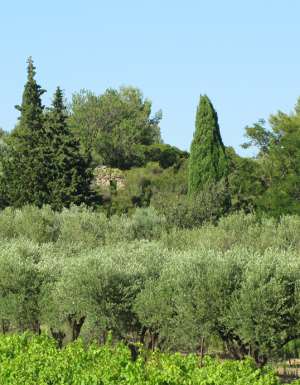 Languedoc
is best known in France for two main reasons;
firstly as a
holiday destination, secondly as France's biggest producer of wine. In
terms of image, it is a region associated with sunshine and the
seaside, but also with its Mediterranean vegetation of vines, olive
trees and slender cypress trees, as in the photo on the right.
Languedoc
is best known in France for two main reasons;
firstly as a
holiday destination, secondly as France's biggest producer of wine. In
terms of image, it is a region associated with sunshine and the
seaside, but also with its Mediterranean vegetation of vines, olive
trees and slender cypress trees, as in the photo on the right.Origins - toponymy
The area known as Languedoc today covers just a small part of the much larger area of France that was known in the Middle Ages as the pays de Langue d'oc.The "Langues d'oc" was a name given to a whole family of French dialects spoken in the southern half of France. In mediaeval times, France was divided linguistically into two main areas, the northern half where people spoke languages that have evolved to produce modern French; and the southern half of the country where they spoke languages somewhere between northern French and Spanish, known as Occitanian French, or langues d'oc. People from the north had difficulty understanding people from the south, and vice versa. The dividing line between the two areas ran from the Charentes in the west to Geneva in the east.
The Languedoc today
Today the Languedoc is part of the large region of "Occitanie", another name that was once used to refer to the whole of the south of France. The name Languedoc-Roussillon until 2016 defined a region stretching from the Rhone to the Pyrenees - a region that still maintains an identity, but is no longer an official administrative division of France .The large majority of the population of Languedoc-Roussillon is concentrated in the urban areas on the coastal plain, notably around Montpellier, Nimes and Perpignan. These are old cities that have grown up over the ages as major points on the land route round the northern Mediterranean coast, the route between France and Spain and Italy and Spain. Montpellier, the regional capital, is the 8th largest city in France, and has been a major European city for over 1000 years. Its university is arguably the oldest in France - its famous schools of law and medicine dating from the twelfth century. But Montpellier is also a modern city that has tried to develop itself, with a certain degree of success, as a major IT and computing centre. ► More information: Languedoc towns and cities
Languedoc wines
The coastal plain of Languedoc is the leading wine-growing area in France. However, volume has fallen over the past decades following a drop in the consumption of ordinary and table wines, which made up the bulk of its production. Faced with this change in the market the Languedoc Roussillon wine industry had to reinvent itself, and did so by targeting new specialties, local wines and increasingly IGP and quality wines. Thanks to abundant sunshine, the warmth of the Languedoc climate, and the southern grape varieties, the wines of Languedoc are full-bodied with a rich flavor and an above-average alcohol level compared to other French wines. These qualities also explain the specialization of certain Languedoc vineyards in fortified wines, aperitif wines such as Frontignan, Rivesaltes or Banyuls, or quite distinctive local wines such as Maury or Fitou.Wthin the Aude department, the area of Limoux is famous for its sparkling wines. Blanquette de Limoux is said to be the oldest sparkling wine in France, and it was from here, in the 16th century, that the monks of Champagne learned the secret to transforming a mediocre white wine into a high-end product, by adding bubbles. ► More information: Wines of France
The Languedoc coast
 The coast of Languedoc was, until the twentieth
century, relatively sparsely populated, as it was bordered by large
expanses of wetlands which bred mosquitos, making the environment
relatively inhospitable. Apart from the extreme south of the region,
where the Pyrenees come down to the coast, the only coastal town of any
importance was Sète, a fishing and trading port beside the
only real
hill along the central Languedoc coast (photo right). But now the
marshes
have been drained, and in the 1960s there was massive
development of
new coastal holiday resorts such as la Grande Motte, Le Grau du Roi,
Cap d'Agde or
Valreas Plage.
The coast of Languedoc was, until the twentieth
century, relatively sparsely populated, as it was bordered by large
expanses of wetlands which bred mosquitos, making the environment
relatively inhospitable. Apart from the extreme south of the region,
where the Pyrenees come down to the coast, the only coastal town of any
importance was Sète, a fishing and trading port beside the
only real
hill along the central Languedoc coast (photo right). But now the
marshes
have been drained, and in the 1960s there was massive
development of
new coastal holiday resorts such as la Grande Motte, Le Grau du Roi,
Cap d'Agde or
Valreas Plage.Today, thanks to its long sandy beaches, hotels and campsites, the Languedoc coast, known as the Amethyst coast, is a popular holiday destination.
Inland Languedoc
Inland from the coastal plain, most of the Languedoc is characterised by dry rocky hills. The exception is the department of the Aude, that stretches inland in the direction of Toulouse, and is famous for its vineyards and its agriculture. To the south, the Pyrenees and their foothills rise steeply towards snowy peaks; and along the northern edge of the coastal plain from Narbonne to Nimes, lie the southern uplands of the Massif Central - a very sparsely populated and arid area. The inland department of Lozère, which covers most of "Haut Languedoc", lies at an average altitude of 886 metres, making it one of the highest departments in France. The dry uplands of Haut Languedoc are cut through by impressive deep river valleys, such as the famous Tarn Gorge.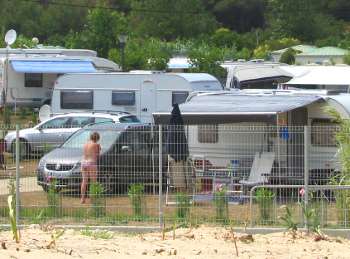
The climate of Languedoc
With the exception of the department of Lozère, Languedoc enjoys a mild to warm Mediterranean climate, making the area attractive to holidaymakers for a good part of the year. Perpignan enjoys a warmer average year-round climate than any other city in France, notably due to its very mild winters. The whole of the coastal area enjoys a dry climate for most of the year, punctuated by occasional monsoon-like heavy rainfalls, known as Cevenol storms (Cevennes storms), which can dump large quantities of water in a very short space of time on the southern slopes of the Cévennes, causing major flooding of rivers such as the Gard or the Herault. This happens most often in late summer and early autumn when warm wet air comes in of the Mediterranean.► Continue to Main towns, cities and other places in Languedoc
► More Tourist attractions in Languedoc
A Gitelink
guide

Historic Carcassonne
Character cottages and B&Bs in Languedoc: map search

The Gorges du Tarn - Lozère

Roussillon coast, near Banyuls and the Spanish border.
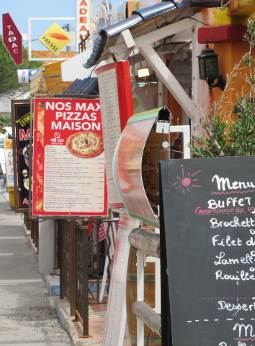
Languedoc resorts have plenty of restaurants and eateries for all tastes.
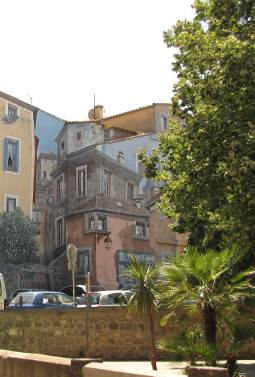
Trompe-l'oeil mural in old Agde.
Photos © Gitelink.com
| Languedoc links |
| Languedoc Roussillon region official site |
| Languedoc wines |
| Languedoc:
About-France.com Small campsites in Languedoc |
| More regional guides |
| Provence |
| Guide to Brittany |
| Guide to the Auvergne |
| Guide to Languedoc-Roussillon |
| Other regions of France |
